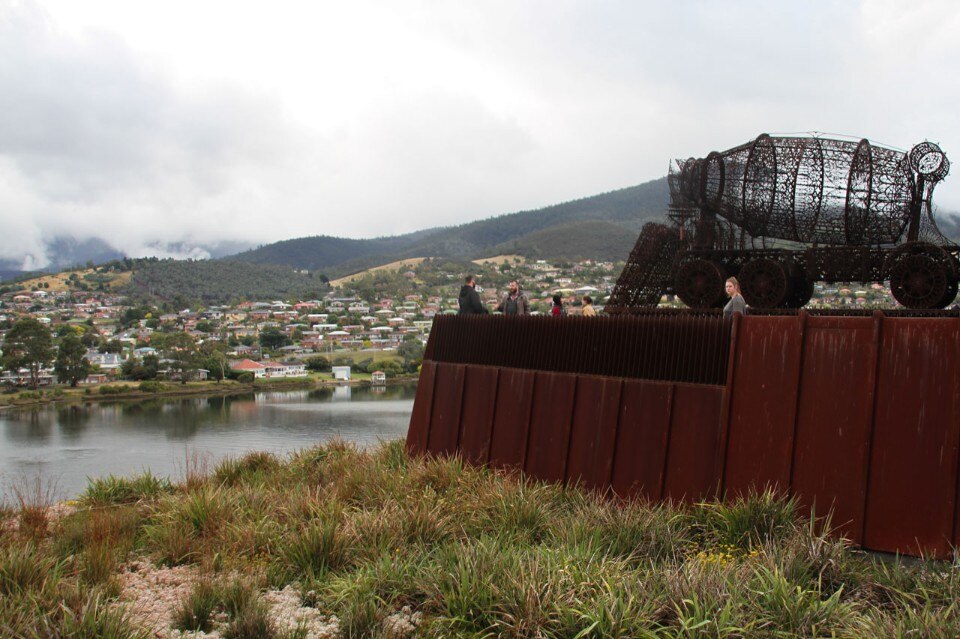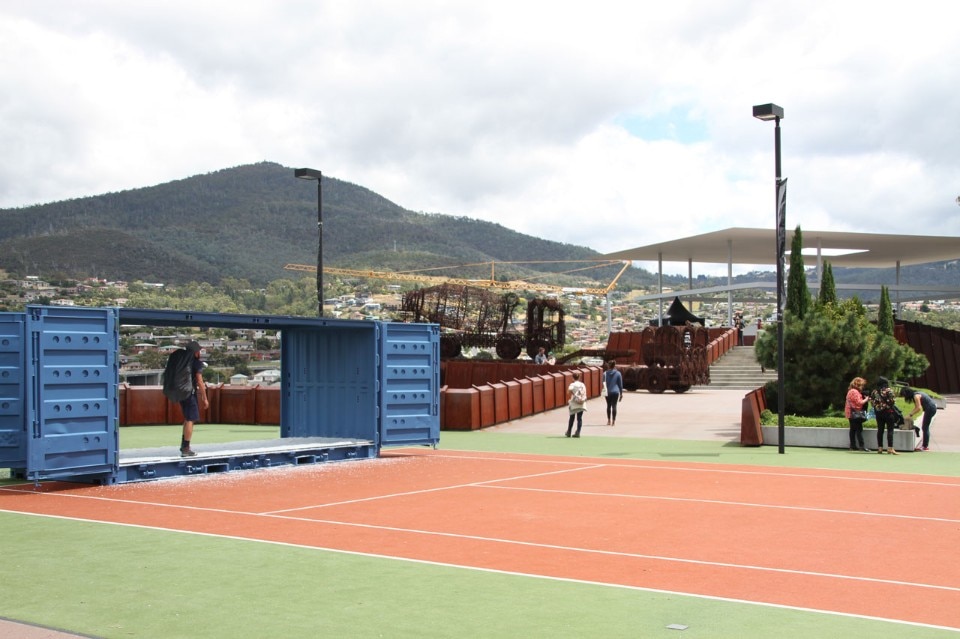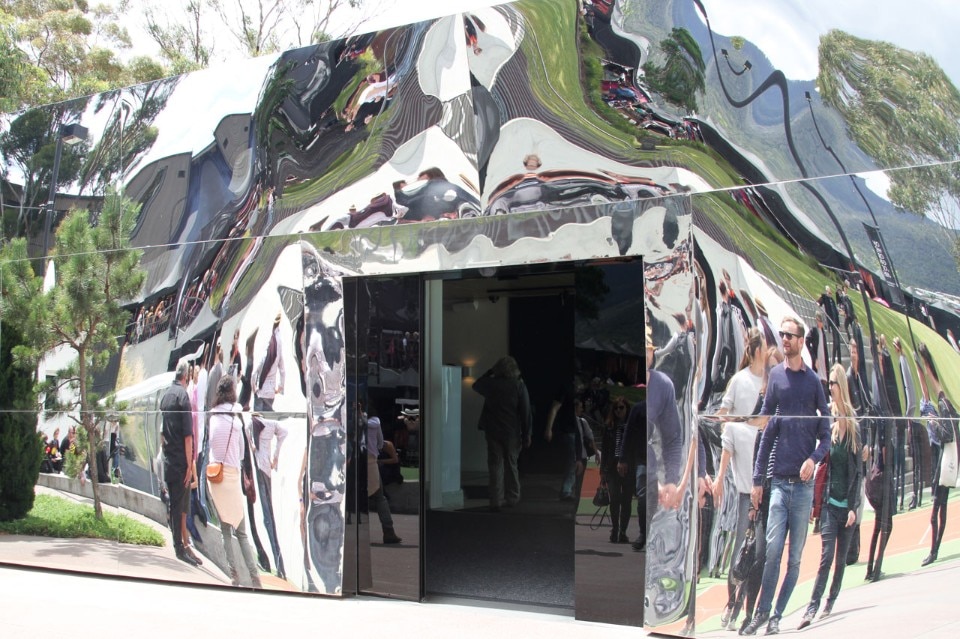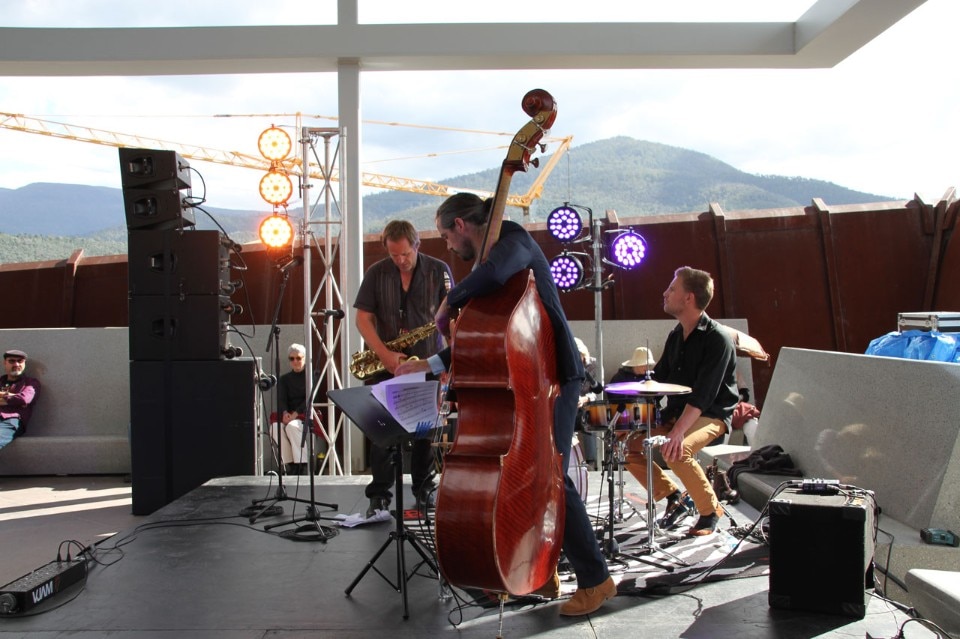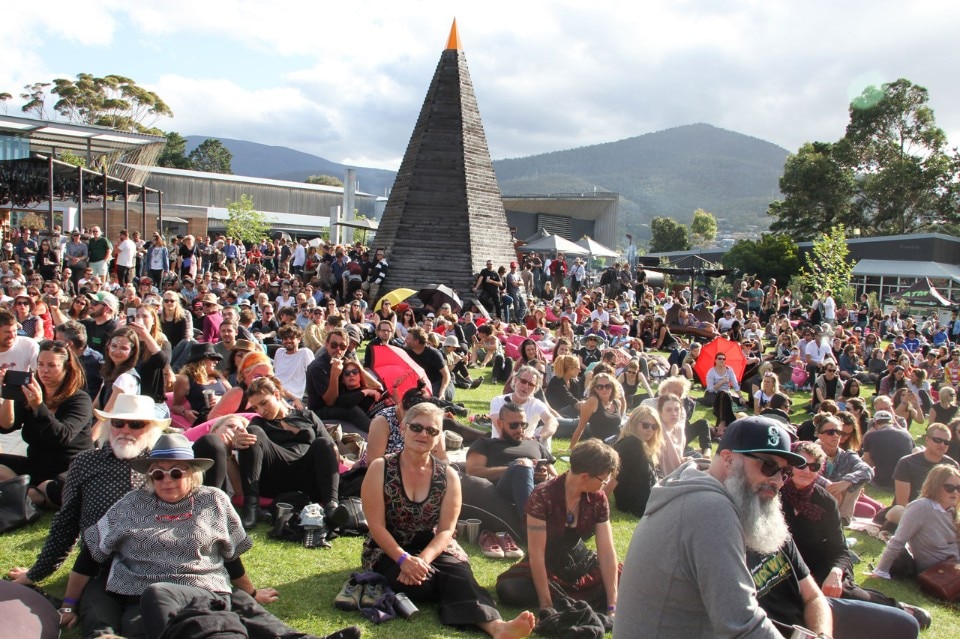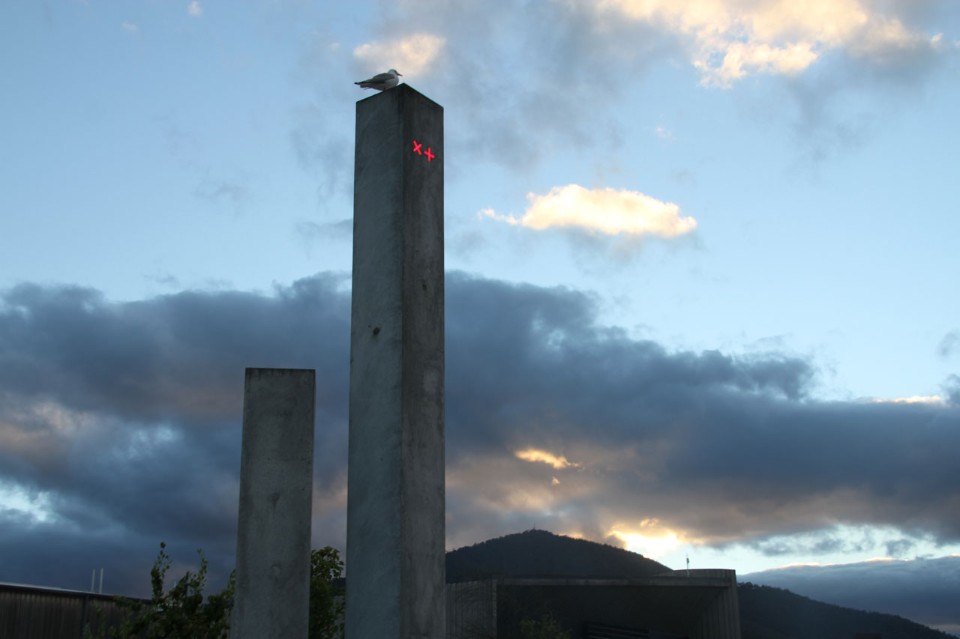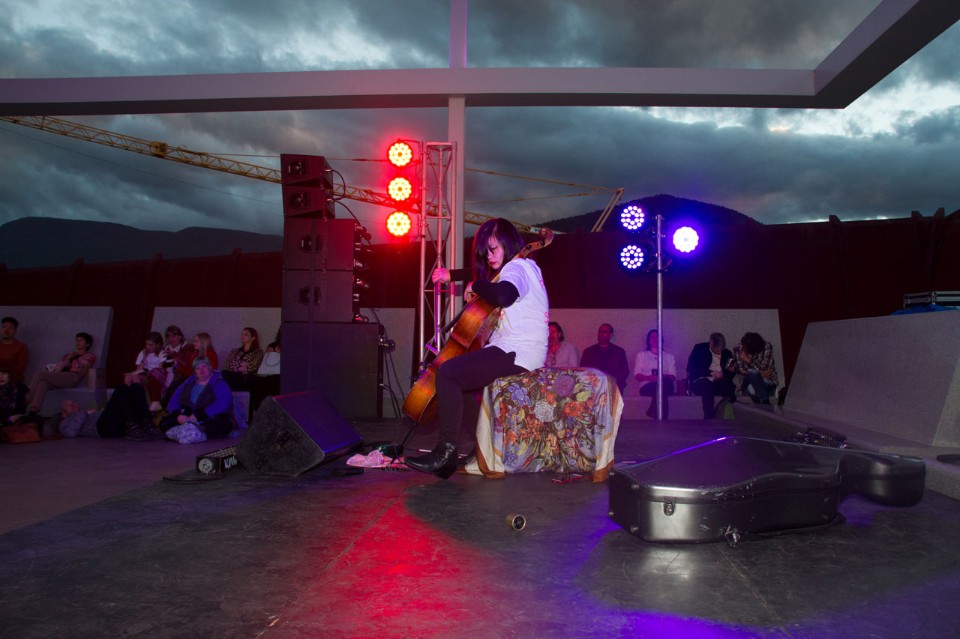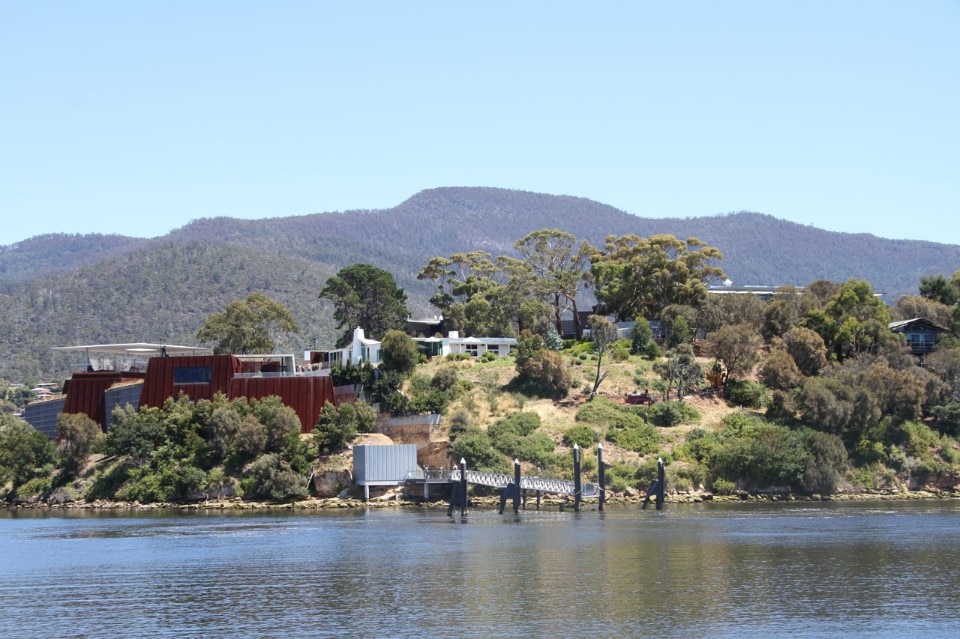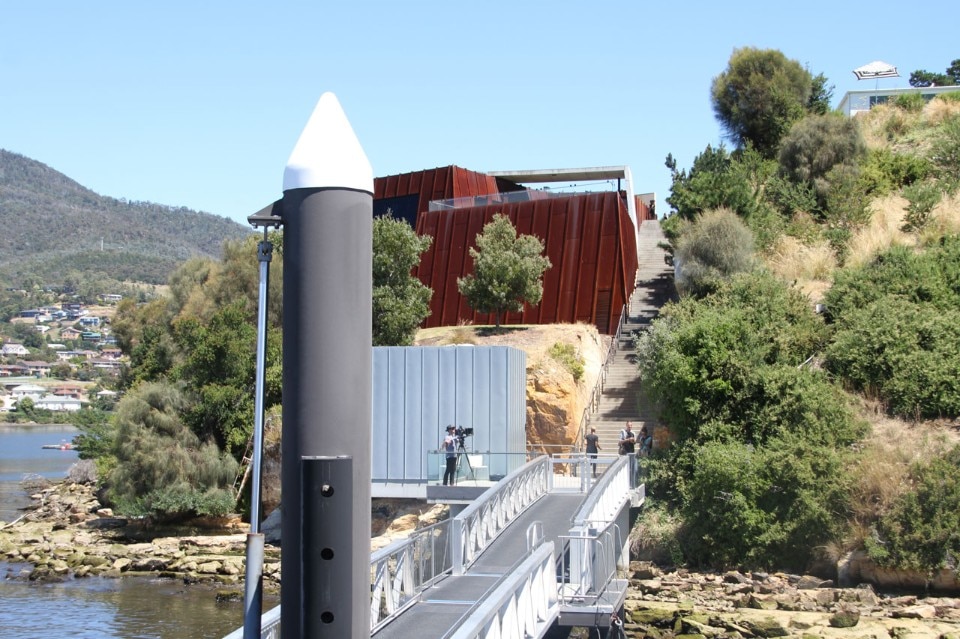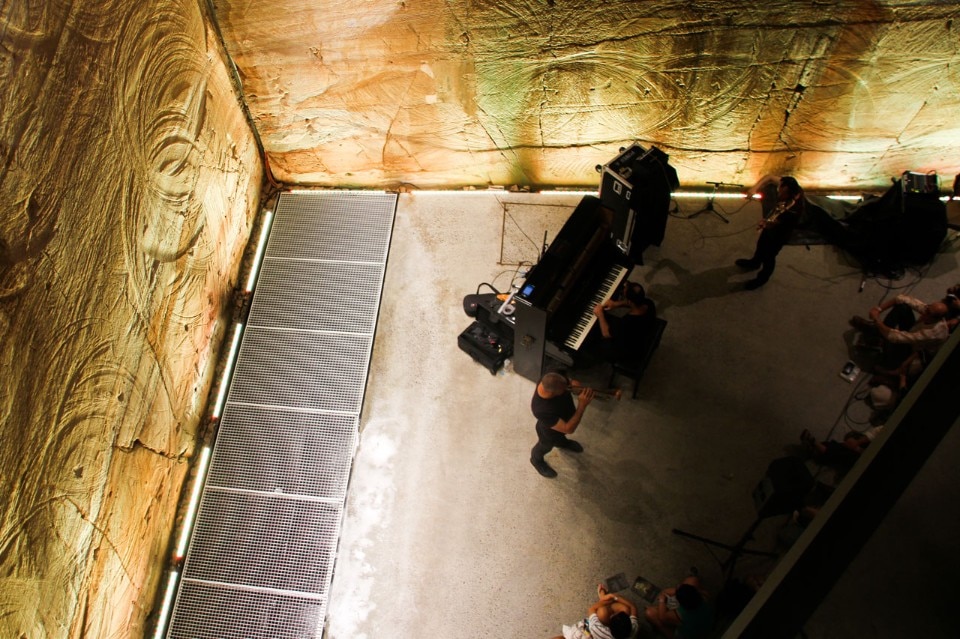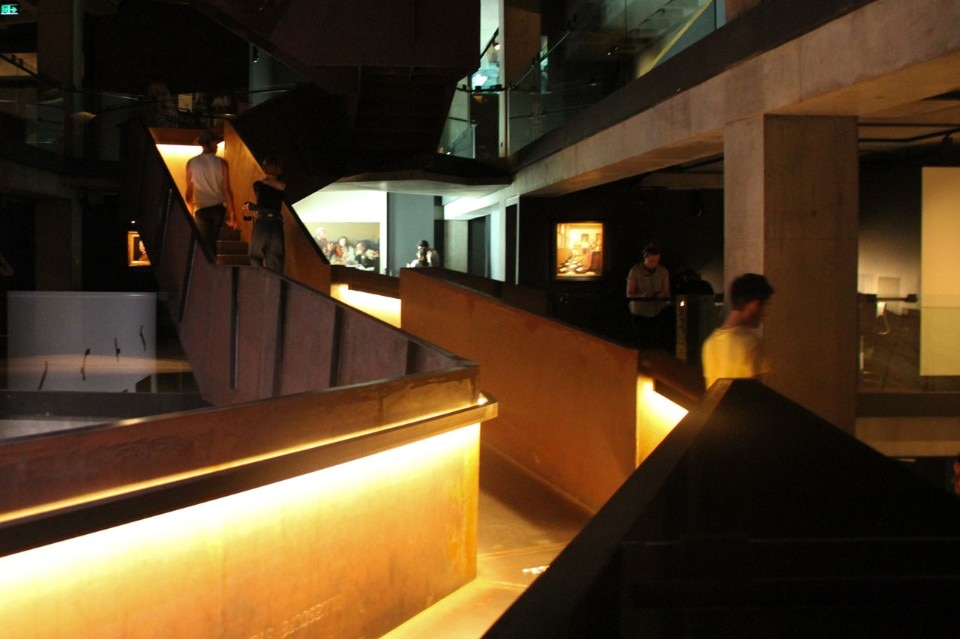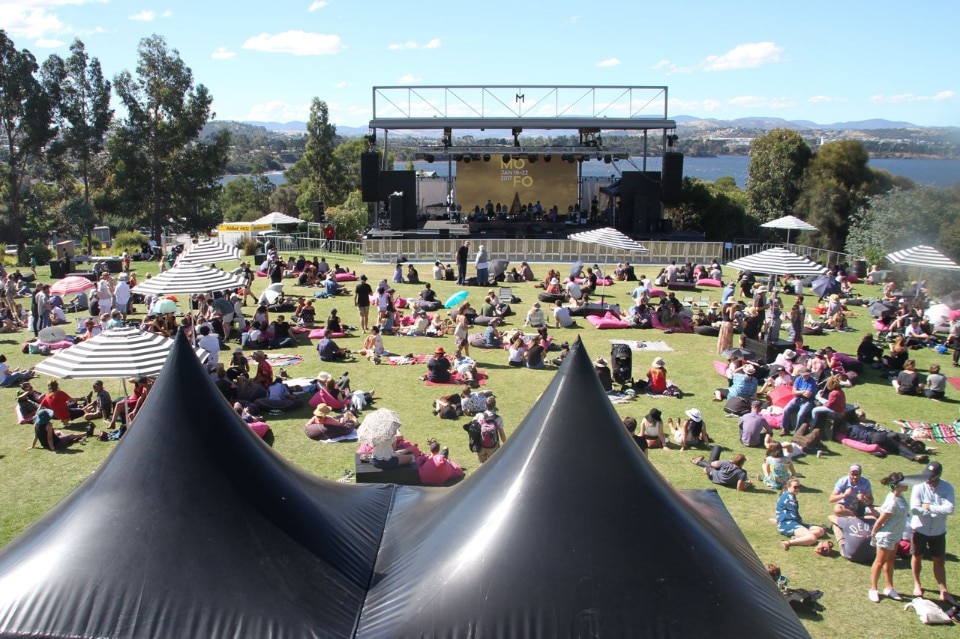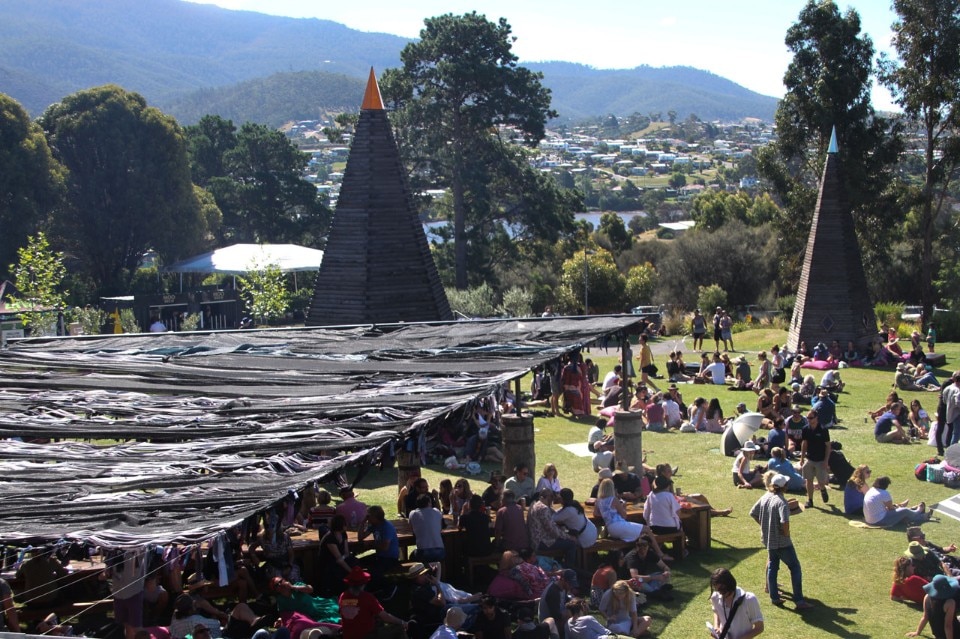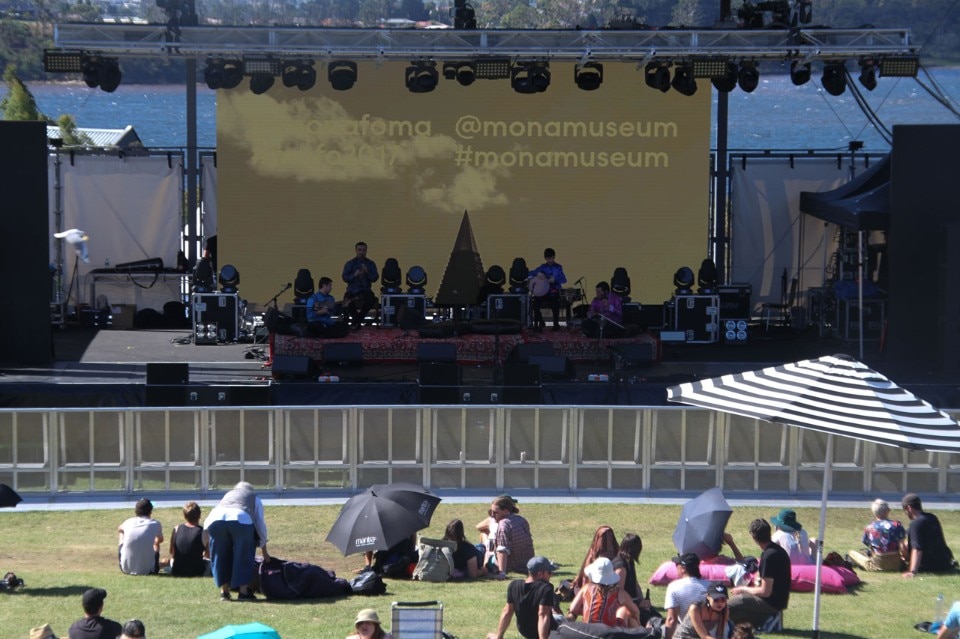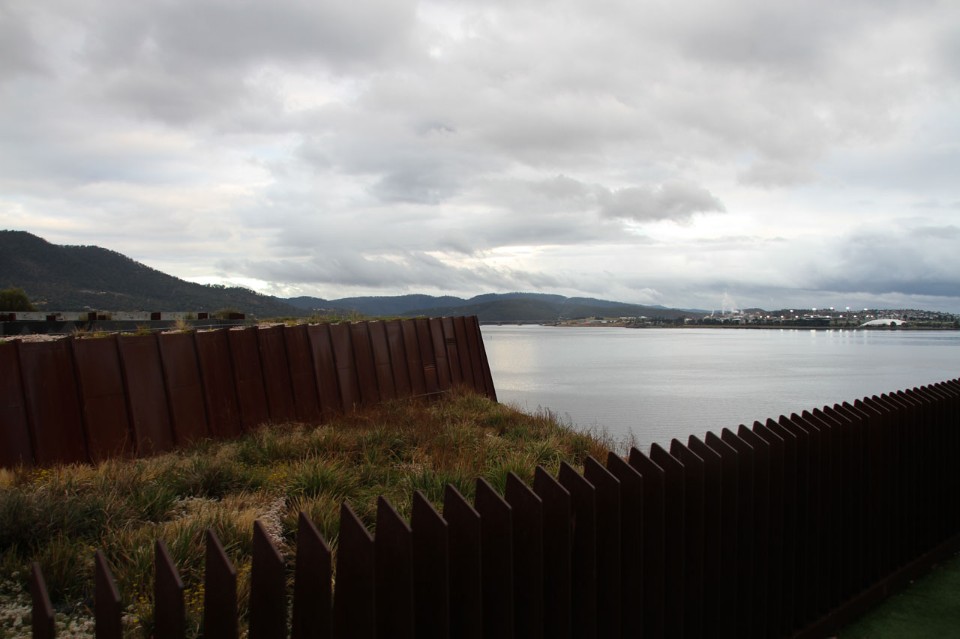
MONA is famed in Australia for being one of the interesting galleries in the country, providing Hobart with credentials as cultural producer to rival any mainland city. Located on a large tract of land overlooking the Derwent river. A particularly inconspicuous mirrored exterior is a portal to an expansive 6,000 sqm labyrinthine network of rooms and tunnels all carved out of raw sandstone and reinforced with steel and concrete. The gallery complex also includes a number of stages, a restaurant, function areas, a vineyard and other spaces.
Philippa Nicole Barr: So how do you use the site? Do you choose the musicians that you think will suit the site, the location and the environment here? Does that have any influences over your choices and decisions?
Brian Ritchie: Well as a result of not having normal or dedicated performance spaces in the museum there’s a strong element of improvising in terms of the programming as well. And yeah the acoustics that we have are a big factor, some of them are quite unconventional. Sometimes we just try to make the best with what we have, like we’ll have something conventional like a string quartet or whatever playing in a venue that normally wouldn't have that, but other times I choose things specifically because I think it might work in the environments that we have, and there are a lot of them. Like you see in this festival we have venues that hold two or three audience members, or using the lifts as a venue.
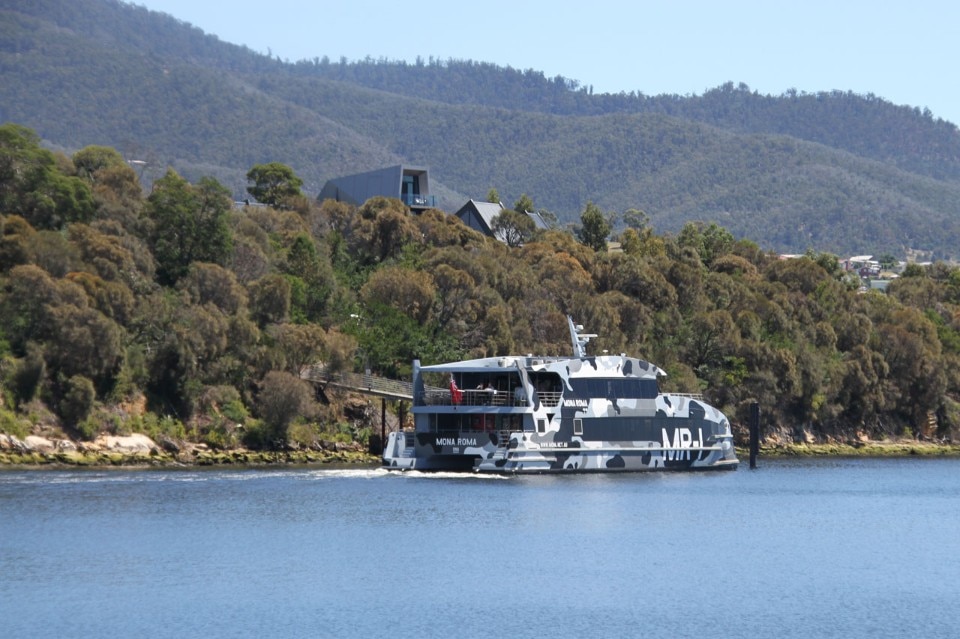
Philippa Nicole Barr: I had a play with that…
Brian Ritchie: We have three lifts we use as venues at different times. We’ve got the Turrell Stage which is a sky scape installation that we use as a stage sometimes, we’re using the barrel room as a venue, in this festival and at other times as well for more conventional musical performances and that’s just where they store the wine barrels. We’re using the winery as a venue, we set up shipping container. We do all kinds of different things and there is a strong element of trying to match the performance to the venue. Or sometimes we’ll just meet a performer we’ll want to work with and then make something happen, make something work
Philippa Nicole Barr: Can you give an example of when that happened?
Brian Ritchie: Like for example in this festival with Ellen Fullman’s long string instrument, because of the length of the instrument we could put it in two different spaces which would be the Void, which is the long stone corridor or the Nolan Gallery which has wood floors so we decided to put it in the Nolan Gallery because of the fact that the wood has a nicer acoustic to it. She’s somebody we’ve been wanting to work with for several years but we never had the right venue. And finally we said ok we’re going to make this work one way or the other, and we put it in the place we really only could put it.
Philippa Nicole Barr: Does it present any kind of special logistical challenges curating a festival like this off mainland Australia, on an island like Tasmania which is so far away, for example getting gear and equipment here, and getting specialized instruments?
Brian Ritchie: There are a lot of logistical problems involved with that, such as there’s only one of everything in Tasmania so if we need two mixing boards we have to send away for one of them. That’s a bit of an exaggeration but it’s not too far from the truth. A lot of the venues don’t have pianos, we finally got a reasonably good piano about two weeks ago, but other venues don’t have pianos.
Philippa Nicole Barr: Do you think the distance from mainland Australia affects the atmosphere of the festival or behavior of the performers in any way, being in this kind of isolated windswept promontory?
Brian Ritchie: Probably there’s a kind of exceeding of expectations that goes on, like people just don’t expect something like this to happen here. For example we had Pantha du Prince, he’s a great German sound artist, he works in the commercial world as well as the art world, and he just said he doesn't think that there’s anything like this in Europe. But he attributed it to the mindset of it than the available talent.
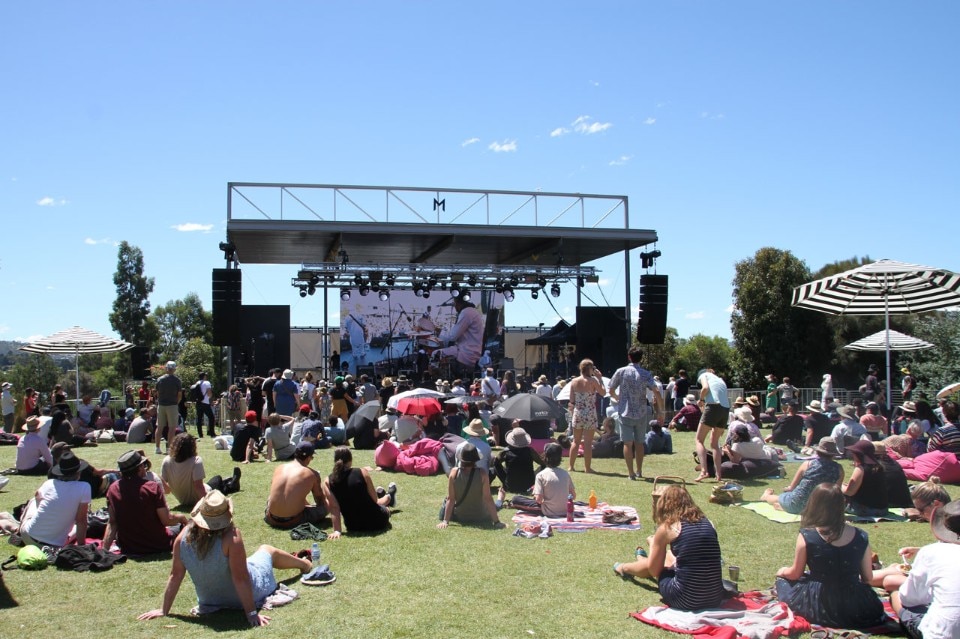
Philippa Nicole Barr: What kind of mindset would that be?
Brian Ritchie: Well the festival is curated to emphasise individuals, usually its individuals or groups with a strong individual leading it, that have a visionary basis – it’s not a genre, it’s not a rock festival or any kind of festival. It’s a music festival that emphasises unusual processes and results, so that’s not commercial and that really goes against the grain, because even festivals that focus on say contemporary classical music or jazz music, in a sense it’s commercial because they’re marketing a certain thing. It’s much broader and it changes every year and it’s intended to change every year and it’s built into our mindset that we will not become formulaic. We don’t want people to come here and say “it’s the same as it was last year”.
Philippa Nicole Barr: It makes for a very unpredictable and in a way random mixture of musicians. Do you try to bind them all together with some kind of curatorial theme or do you just let it happen?
Brian Ritchie: There are always a few themes that I usually don’t tell anyone, and people usually figure it out and if they don’t that's fine because I know that’s tying things together in a way. But there’s usually more than one of them.
Philippa Nicole Barr: Like what?
Brian Ritchie: Like this year one of the themes is primitive and early electronic music making devices. So we’ve got Theremin, Robin Fox and Byron’s vintage synthesizer collection, Kaitlyn Aurelia Smith.
Philippa Nicole Barr: You’ve got Daphne Oram’s stuff too.
Brian Ritchie: Yeah. So we’ve got all that stuff happening, we didn’t say anything in our press release but it’s there. And then a related theme, which only really makes sense in relationship to that theme, is a bunch of acoustic instruments that sound like they’re electronic instruments, like Ellen Fullman’s Long string instrument, the overtone groups, metal rods that sound like sign waves, and others.
Philippa Nicole Barr: Would that be the vision behind the Mike Patton grouping called tētēma?
Brian Ritchie: Well yeah because Anthony [Pateras]’using revox tape recorders and other kind of analogue means of creating synthesis, so it’s loosely tied in with that. Then there are other themes that carry on from one festival… every festival has improvising as a theme. Every festival has collaboration as a theme. So from there you’ve got a number of themes or practices. They’re modular, so you can have them superimposed upon each other or standing alone.
Philippa Nicole Barr: Can you identify any things that you want to try in the future that you haven’t tried yet, or are there any bands you want to bring out, or any risks you want to take, stuff you want to work on next?
Brian Ritchie: Although it may look like we have a huge budget we don’t really have a huge budget, we’re just very efficient with our budget so at a certain point we can’t do things. Like this year we did an opera but it was an opera with one singer…
Philippa Nicole Barr: Peaches right?
Brian Ritchie: Well yeah that was an opera that was just one singer and a piano player, it was amazing, but that's not a full blown opera, then we had another opera “Before the flame goes out”, by IHOS Amsterdam and composed by Constantine Koukias, which is one singer and five musicians.
Philippa Nicole Barr: That’s awesome.
Brian Ritchie: So it’s a contemporary opera but we have yet to do a full blown opera, also there is no venue for it. It would be nice to eventually have a bigger budget and do some real grand scale things, more orchestral things. But I’m happy to work with whatever we’ve got and just maximize the creativity of the people there. Give the artists a lot of freedom.
Philippa Nicole Barr: And for the future, how do you feel about working with just this location, this site, which is so specifically MONA or moving more into the city? Do you prefer working with the venues that exist within the city, for example, the Hobart Town Hall, or do you prefer being out here in a more concentrated festival environment?
Brian Ritchie: This is the ninth festival. And this is only the second one here at MONA. The other seven before that were in the city except one where we split it up, we did seven days in the city and three days out here. We moved out here just to stop it from being formulaic. We’re going to do construction and we’re going to have to anyway go back to the city or some other idea in a couple of years before we start construction here. It will definitely be moving again.
Philippa Nicole Barr: What kind of construction?
Brian Ritchie: We’re building a hotel and there’ll be a venue involved with that too, a thousand seated venue. So it’s good for us in the long term.

